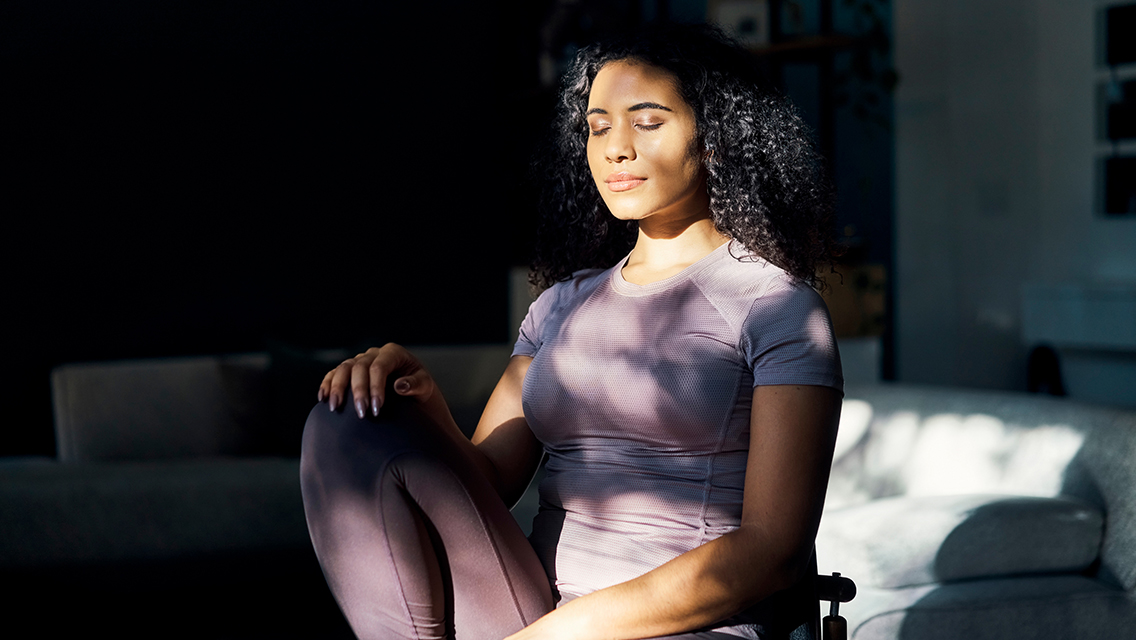Often when people visualize success in fitness endeavors, they visualize reaching an end goal, such as PRing their deadlift or crossing the finish line of their first triathlon.
Rare is the athlete or gym-goer who applies visualization techniques to the many possible steps in their fitness journey, be it walking through the doors of a new health club for the first time, establishing a wake-up routine that reliably leads to an early morning workout, or performing the warm-up reps necessary for achieving a future personal best.
These interstitial stages might seem boring — a dull, blurry grayscale compared with the vivid sensory experience of reaching a major goal. But visualizing the small steps is precisely the type of mental performance training that can set you up for achieving those big successes.
It’s vital, in other words, to picture the journey. Experts explain how visualization can help you do just that.
The Benefits of Visualization
The mind is a powerful tool, and it’s the mind’s power that makes mental performance training — and visualization in particular — so effective.
“Visualization, or guided imagery, uses our own imaginations to elevate how we show up or perform,” says Life Time Mind coach Barbara Powell, MA, NBC-HWC. “Our brain doesn’t really sense or know the difference between an imagined image and reality.”
For example, just imagine you are eating a lemon, and notice how your mouth begins to salivate or pucker — that’s your body responding to your thoughts, Powell says. “This shows how potent imagery can be. Our mind creates our reality.”
Data backs this up: A meta-analysis of studies concluded that mental imagery improved motor performance, motivational outcomes, and positive feelings associated with sport. The research, published in the International Review of Sport and Exercise Psychology, found that imagery plus physical training is more effective than physical training alone — and the more you practice imagery, the greater the benefits.
Picturing the process can help you better accomplish your sports or fitness goals in a couple of ways. For instance, it provides more practice time.
“You can rehearse sports skills or strategies without having to physically be in training,” says Greg Chertok, a certified mental performance consultant with Telos Sports Psychology Coaching. Visualization allows you to complete more reps or practice an activity without actually doing it.
Not only can you do that anywhere — on a bus or train, or while taking a walk or lying in bed — but it also can reduce the risk of overtraining. “You can visualize certain reps in the gym or an arduous uphill run without the physical strain,” he explains.
Of course, mental performance training doesn’t replace your workouts. “Visualization is complementary to our physical training,” says Powell.
Another perk is its ability to boost your confidence. “If I can imagine overcoming some obstacle or seeing myself be successful,” notes Chertok, “this facilitates confidence and heightens my motivation to physically do it for real.”
Imagining Process vs. Outcome
Though visualizing success is a powerful tool, research suggests that what exactly you visualize makes a difference.
In the late 1990s, researchers at the University of California, Los Angeles, set out to determine whether it was better to visualize having achieved a goal (outcome visualization) or to visualize the steps needed to achieve a goal (process visualization).
Study participants were divided into three groups: A process-visualization group spent five minutes a day imagining studying for an exam: sitting at their desks, studying book chapters, turning off the television, turning down invitations to go out, etc. An outcome-visualization group spent the same amount of time visualizing themselves receiving an A on the exam. The control group was given no visualization instructions.
The process-oriented group started studying earlier, studied for more hours, and achieved an average exam grade more than five points higher than the outcome-visualization group and about eight points higher than the control group.
The researchers found that the process-oriented group started studying earlier, studied for more hours, and achieved an average exam grade more than five points higher than the outcome-visualization group and about eight points higher than the control group. In other words, any visualization was better than none at all — but the process-oriented participants had a notable leg up.
Chertok explains that outcome visualization “runs the risk of tipping into fantasizing — that you’re thinking only of the outcome you want to achieve.”
This can drain the energy needed to complete the tasks required to make progress. Process visualization is the counterpart: It encourages you to imagine the actions you’ll actually take to reach the desired outcome.
Believe Your Senses
Using imagery is one of the most powerful ways to bring process visualization to your training, says Chertok. Imagery involves calling upon the five basic senses — sight, sound, touch, smell, and taste — to create a realistic experience in your mind.
Begin practicing this by noticing your sensory responses in the moment. Whether you’re lifting weights, riding your bike first thing in the morning, going for a run after work, or lacing up for a game of pick-up basketball, pay attention to what you can see, hear, smell, taste, and touch.
What does the barbell’s knurling feel like as you grip it while deadlifting, for instance? Can you smell the morning dew in the air during your training ride? While sipping your homemade electrolyte drink during your long run, can you pinpoint the flavors of salty, sour, and sweet? What does a basketball whooshing through a hoop sound like?
As you develop the skill of noticing your senses in real time, it becomes easier to evoke them while visualizing your lifts, rides, runs, free throws, and more, no matter where you are. The better you are at this, the more vivid your imagery will become — and the more effective it will be, says Chertok.
“Our ability to mentally prepare can be identical to how elite performers do it.”
Once you get the hang of building imagery, you can expand your visualization technique to include both internal and external perspectives. “Internal” means that you see the scene from your own eyes: You are doing the action. “External” means that you’re watching yourself do something from a third-party perspective.
“There is so much flexibility in the modality,” Chertok explains. Experiment with how and when you use imagery to “find what feels the most comfortable and confidence-boosting for you.”
Visualization can help us elevate our mindset and prepare mentally for hard efforts, adds Powell: “So, use it to dream big.”
This article originally appeared as “Picture the Process” in the March/April 2024 issue of Experience Life.
Go Deeper
Guided imagery can be a powerful support for health recovery, goal realization, and emotional healing. See “How Guided Imagery Can Boost Your Health — and Performance” to learn more.





This Post Has 0 Comments